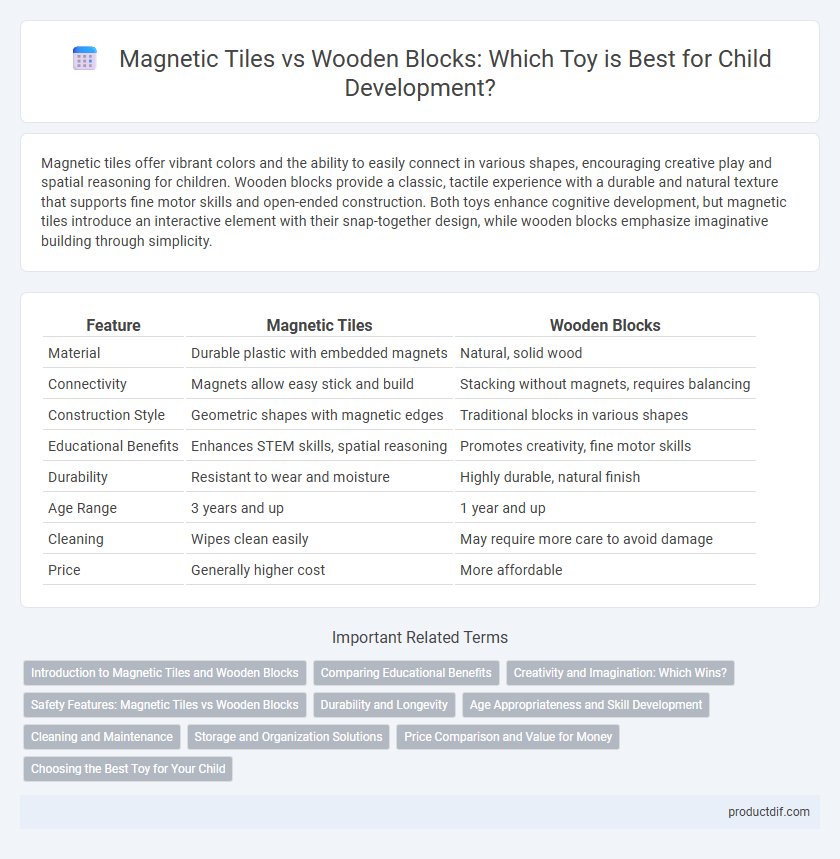Magnetic tiles offer vibrant colors and the ability to easily connect in various shapes, encouraging creative play and spatial reasoning for children. Wooden blocks provide a classic, tactile experience with a durable and natural texture that supports fine motor skills and open-ended construction. Both toys enhance cognitive development, but magnetic tiles introduce an interactive element with their snap-together design, while wooden blocks emphasize imaginative building through simplicity.
Table of Comparison
| Feature | Magnetic Tiles | Wooden Blocks |
|---|---|---|
| Material | Durable plastic with embedded magnets | Natural, solid wood |
| Connectivity | Magnets allow easy stick and build | Stacking without magnets, requires balancing |
| Construction Style | Geometric shapes with magnetic edges | Traditional blocks in various shapes |
| Educational Benefits | Enhances STEM skills, spatial reasoning | Promotes creativity, fine motor skills |
| Durability | Resistant to wear and moisture | Highly durable, natural finish |
| Age Range | 3 years and up | 1 year and up |
| Cleaning | Wipes clean easily | May require more care to avoid damage |
| Price | Generally higher cost | More affordable |
Introduction to Magnetic Tiles and Wooden Blocks
Magnetic tiles are colorful, geometric plastic shapes embedded with magnets along their edges, allowing children to build 3D structures that promote creativity and spatial reasoning. Wooden blocks are classic, solid pieces made from natural wood, known for enhancing fine motor skills and encouraging open-ended imaginative play. Both toys support cognitive development but differ significantly in sensory experience and construction possibilities.
Comparing Educational Benefits
Magnetic tiles enhance spatial reasoning and STEM skills by enabling children to create 3D structures with interactive magnetic connections, fostering problem-solving and creativity. Wooden blocks promote fine motor skills and imaginative play through tactile manipulation and open-ended building, encouraging cognitive development and hand-eye coordination. Both toys support early childhood learning but target different developmental strengths, making them complementary educational tools.
Creativity and Imagination: Which Wins?
Magnetic tiles elevate creativity by allowing children to construct dynamic, three-dimensional structures with vibrant colors and geometric precision, stimulating spatial thinking and imaginative design. Wooden blocks offer tactile, versatile play that encourages open-ended building and problem-solving, nurturing imaginative storytelling and hands-on exploration. While magnetic tiles foster innovative architectural concepts, wooden blocks provide a foundational experience that enhances sensory development and imaginative freedom.
Safety Features: Magnetic Tiles vs Wooden Blocks
Magnetic tiles feature embedded magnets with secure, child-safe coatings to prevent choking hazards and ensure strong, stable connections, reducing the risk of pieces coming apart during play. Wooden blocks are typically made from non-toxic, untreated or minimally treated wood, often sanded smooth to avoid splinters, and lack small detachable parts, which lowers choking risks but may pose issues if coatings are not child-friendly. Both toy types prioritize safety, but magnetic tiles offer enhanced stability and fewer loose parts, while wooden blocks rely on natural materials and craftsmanship for safe, durable play.
Durability and Longevity
Magnetic tiles offer high durability due to their sturdy plastic construction and strong embedded magnets, resisting chipping and warping over time. Wooden blocks, made from solid hardwoods like maple or beech, provide exceptional longevity with the ability to withstand rough play and maintain structural integrity over years. Both toys show impressive durability, but wooden blocks often outlast magnetic tiles in terms of lifespan, especially with proper care and maintenance.
Age Appropriateness and Skill Development
Magnetic tiles are ideal for children aged 3 and up, enhancing spatial reasoning and fine motor skills through interlocking shapes and vibrant colors. Wooden blocks suit a broader age range, from toddlers to older kids, promoting creativity, hand-eye coordination, and problem-solving abilities with their tactile, open-ended play. Both toys support cognitive growth but differ in sensory engagement and complexity suited to developmental stages.
Cleaning and Maintenance
Magnetic tiles are typically easier to clean due to their smooth plastic surfaces that resist stains and can be wiped down with a damp cloth, preventing the buildup of dirt and germs. Wooden blocks require more careful maintenance as they can absorb moisture and dirt, potentially leading to warping or splintering over time, necessitating occasional sanding and oiling to preserve their quality. Choosing magnetic tiles can reduce cleaning time and effort, while wooden blocks demand consistent upkeep to maintain their durability and safety.
Storage and Organization Solutions
Magnetic tiles offer compact storage with their flat, stackable design, allowing easy organization in small containers that prevent pieces from scattering. Wooden blocks often require larger, open bins due to inconsistent shapes, making neat storage more challenging. Choosing magnetic tiles enhances space efficiency and simplifies clean-up, promoting a tidier play area.
Price Comparison and Value for Money
Magnetic tiles typically cost more than wooden blocks due to their advanced design and included magnets, with prices ranging from $20 to $50 for sets that encourage STEM learning. Wooden blocks, priced between $10 and $30, offer timeless durability and versatility, providing long-term value in open-ended play. Considering educational benefits and build quality, magnetic tiles deliver higher value for money in fostering creativity and cognitive skills, while wooden blocks remain a cost-effective, classic option for foundational play.
Choosing the Best Toy for Your Child
Magnetic tiles offer versatile, colorful construction options that enhance spatial reasoning and fine motor skills through engaging, open-ended play. Wooden blocks provide tactile strength and natural texture, fostering creativity and problem-solving while promoting eco-friendly practices. Selecting the best toy depends on your child's developmental needs, preferences, and the desired balance between educational value and sensory experience.
magnetic tiles vs wooden blocks Infographic

 productdif.com
productdif.com